Tags
April, Birds, early spring, Fairy Glen, grey wagtail, Old Colwyn, river Colwyn, wildflowers, woodland
Slow to get going, this early Spring has been a bit of a roller-coaster weather-wise, with temperatures yo-yoing up and down almost on a daily basis. On occasional days the sun has been hot enough to burn, but most have been cloudy cool and at best damp from frequent rain showers. But the progress of Spring carries on apace and I don’t want to miss it, so I remind myself that cool, damp, cloudy days can be just as rewarding as warm sunny ones, especially if you’re out between showers or soon after rain has stopped. On such a day I headed for one of my favourite places to meander – alongside the little River Colwyn where it runs through Old Colwyn and completes its journey to the sea.
On damp grassy banks the flowers of celandines and daisies are closed against the damp and lack of sunshine.
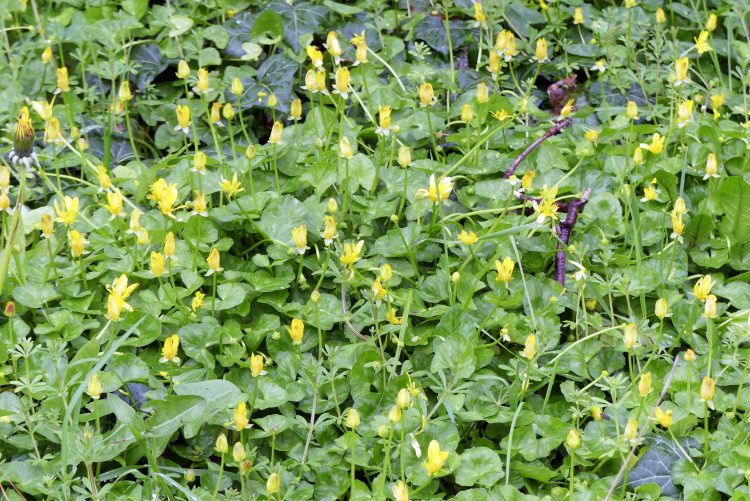
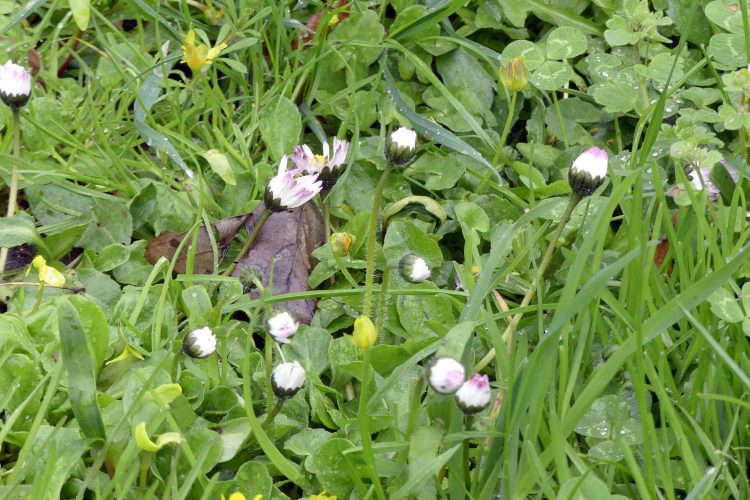
The river is rarely deep, but today it was full enough to cover most of its rocky bed, shallow enough to create falls and white water where levels drop down, and running fast enough to make itself heard as it raced towards the sea.
The limestone wall that keeps it within bounds, damp from recent rain is decorated on the road side with opportunistic little plants; prettiest now were ivy-leaved toadflax with its little lilac-mauve flowers and the succulent grey-green leaves of a stonecrop.
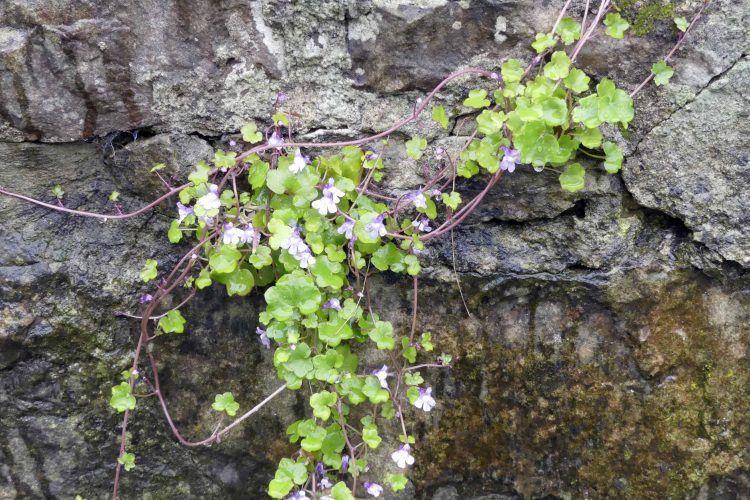

Coed Myn y Don Woodland
The board illustrating some of the variety of trees that grow in this remnant of woodland is slowly being integrated into its surroundings, but is just about legible. Part natural woodland and part garden, there’s an interesting mix of flora here, trees, native wildflowers and cultivated ones blend well, and together with the river they help make this a valuable haven for some of our local wildlife. In places though, wildflowers are in danger of becoming overwhelmed by rapidly-spreading winter heliotrope, as I’m finding increasingly in other local spots I visit.
The golden flowers of a plant I hadn’t noticed here before caught my eye. Growing through grass and other plants, a small patch of the rather inelegantly named opposite-leaved golden saxifrage, which favours growing in damp, even boggy shady woodland places.


On the sloping bank that follows the curve of the river are primroses, which smelt delicious, common dog violets, wood anemone, whose flowers were closed and dog’s mercury.
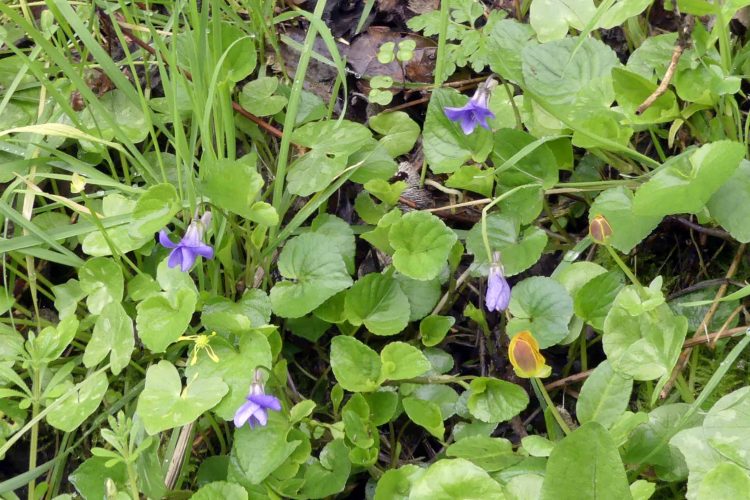
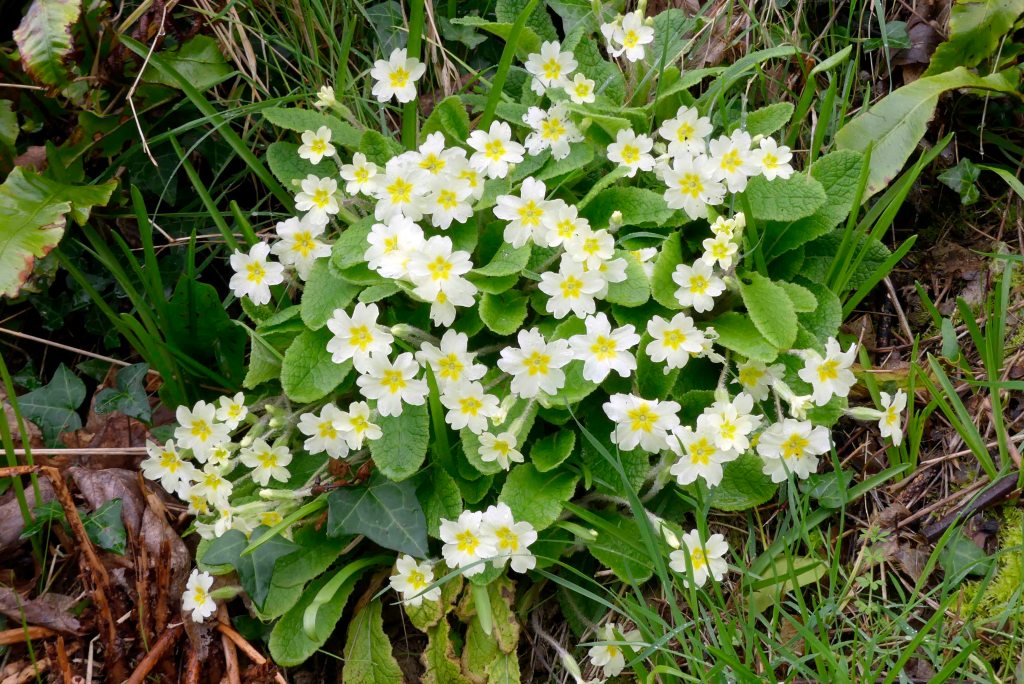
Over the years, this has consistently been one of the very best places I know for hearing and seeing birds, and I wasn’t to be disappointed today. A chorus of birdsong accompanied the sound of the water; I stop to listen and although the songsters are hidden from sight, I heard a melodious blackbird, a robin, a few notes from a wren as it broke from cover and a taunting chiffchaff, one of my ‘targets’ for today, which frustratingly I couldn’t locate.
Tan y Bryn Gardens
On the bank just inside the entrance to the gardens the strange other-worldly shoots of one of our most ancient wild plants, horsetail, are already grown quite tall. A notoriously stubborn garden invader, I wonder if some of the plants are deliberately left, or whether they just refuse to be banished. A little further on, where water pools at the bottom of the slope, another alien-looking bud, this one enormous and belonging to the giant gunnera (aka giant rhubarb) with its correspondingly enormous leaves.
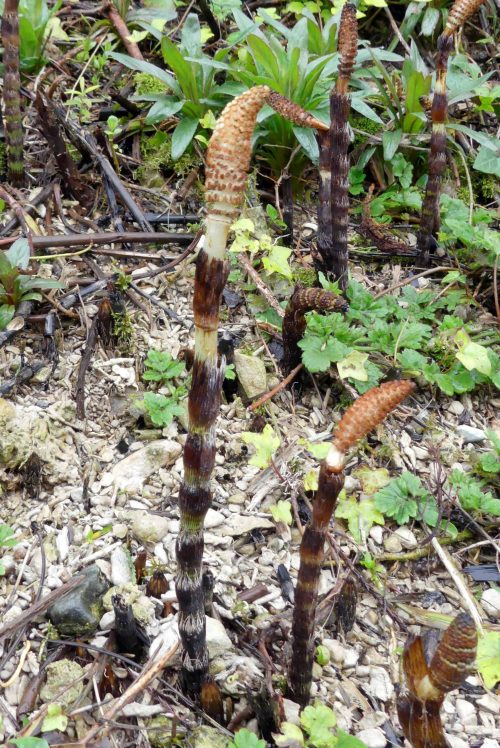

I stopped to listen to a song thrush. Perched in the shade on a branch of a tree close to the path he was singing enthusiastically, as song-thrushes do, then every so often pausing. In those intervals I could hear another song thrush singing from some distance away, in the woodland that continues on the other side of the road. They were clearly communicating, perhaps confirming their territorial claims, or maybe just having a conversation, discussing the sorry mess their human neighbours are making of things.
As I stood listening to the thrushes, a robin, rapidly followed by another flew right in front of me, so close I’m amazed they missed me. They headed straight into a shrub, routing out a third robin, which flew out at speed and dived into a tree. The other two, most likely a pair, were right on its tail and the three of them chased across the road, where the ‘invader’ departed, leaving the others to regain their composure on a garden wall.
They weren’t the only ones chasing about; just seconds later two dunnocks raced past me. One disappeared from sight while another landed quite prettily in the middle of a flowering shrub.
Moving on, I was keeping an eye on the river and also scanning the rooftops of houses opposite, hoping to catch sight of a grey wagtail, always one of the special birds I hope to see here.
The damp short turf alongside this stretch of path is a favourite spot for foraging blackbirds and I’ve also seen both song and mistle thrushes here on occasions. Today it was left to a single pair of blackbirds out hunting together, which probably means they have young, hungry offspring to feed.
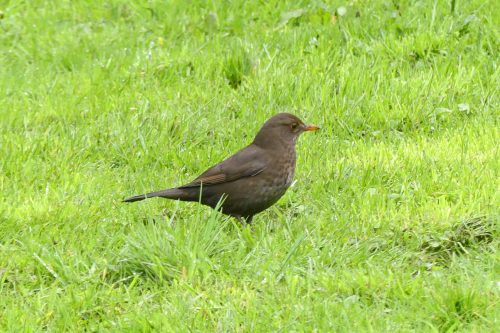
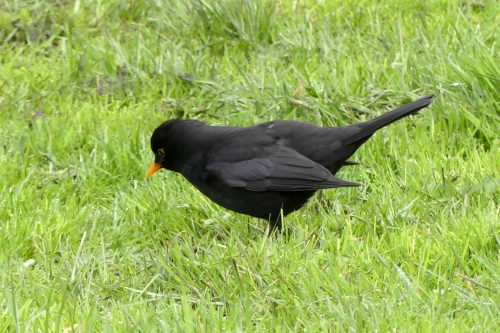
Nearing the top end of the gardens, one of my favourite local trees overhangs the path. A Japanese cherry, this beautiful tree is one of the highlights of a walk here at this time of year and is a total treat for the senses. Its snowy white blossom, which usually appears before the leaves, looks beautiful and has the most delicious rich honey-almond-y fragrance, which on a warmer, sunnier day might have been visited by bees. I’m not entirely certain, but I think it’s a Mount Fuji Cherry, named for the holy Japanese mountain covered with eternal snow
Following on from the sublime beauty of the tree, the next part of the path, which together with the river, passes under buildings and the main road through the village, has less appeal. Sadly, this lovely little river is prone to having rubbish thrown into it, most frequently glass and plastic bottles and drinks’ cans etc., but also random bigger items. Today’s photograph contains the frame of a pushchair.
Nearing the underpasses, I was distracted from thoughts of littering and fly-tipping by a flash of yellow and the flickering movements of a bird amongst the thicket of old ivy that covers the wall to the right of where the river flows through. There, inspecting the dried materials amongst the twining stems, a female grey wagtail was taking her time searching for pleasing pieces, which I think it’s safe to assume, would contribute to the construction of a nest.
She was joined by a slightly brighter, more colourful male, who made several attempts to get closer to her, but definitely wasn’t interested in helping to collect nesting material. I watched them for quite a few minutes – she picking out bits and dropping them when she found something better; he flying off and coming back several times until they finally flew off together, up and over the wall and away over the houses on the far side of the road. Not the direction I’d expected, but maybe they were making a distracting detour to their nest site.
Some of the lack of beauty of the pedestrian underpass has been made up for by some colourful, well-painted graffiti on the outside entrance and along the inside walls of its length. At the moment it’s further enhanced by one of the biggest patches of ivy-leaved toadflax I think I’ve ever seen.
Inside, my favourite piece of graffiti art cleverly depicts the part of Abergele Road, which is immediately above, but as it may have looked when the tram ran through it, and also the viaduct which spans the bottom of the road where I began my walk.
Llawr Pentre
The underpass leads through to the part of the village known as Llawr Pentre. Down below the level of today’s village, this was where Old Colwyn originated and was where the ford across the river was located. Here too were a flour mill, dating back to pre-1750, a farm, a slaughter house, a wheelwright, a saddlery, and a butcher’s shop. Now it is purely residential and the access road lined with parked cars. Maybe not the most attractive part of the river’s journey, but it runs through regardless, and perhaps surprisingly, it is often a part visited by grey wagtails, so always worth a look. And lo and behold, as I was lingering noting wildflowers on the river edge, in flew this beautiful male who landed first on an overhead cable, then flew down onto a ‘for sale’ board. First thoughts were this was the male I’d seen on the other side of the underpass, but he had the black throat and bib of his breeding plumage, while this one didn’t.
The path loses the river for a while as you have to divert around private grounds. Steep steps lead up to a lane which you then follow towards the woodland dell of Fairy Glen. At the top of the steps a female house sparrow was feeding on seeds of a sowthistle. She is doubtless one of the members of the flock that inhabit the thick mixed hedge that borders one side of the lane. Hearing the lively cheeps chirps & squabbles of the house sparrow couples hidden from view inside there always make me smile when I pass by here.
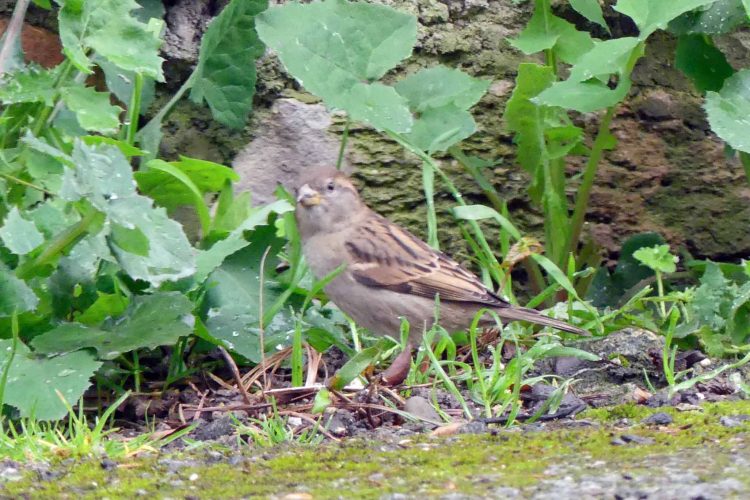
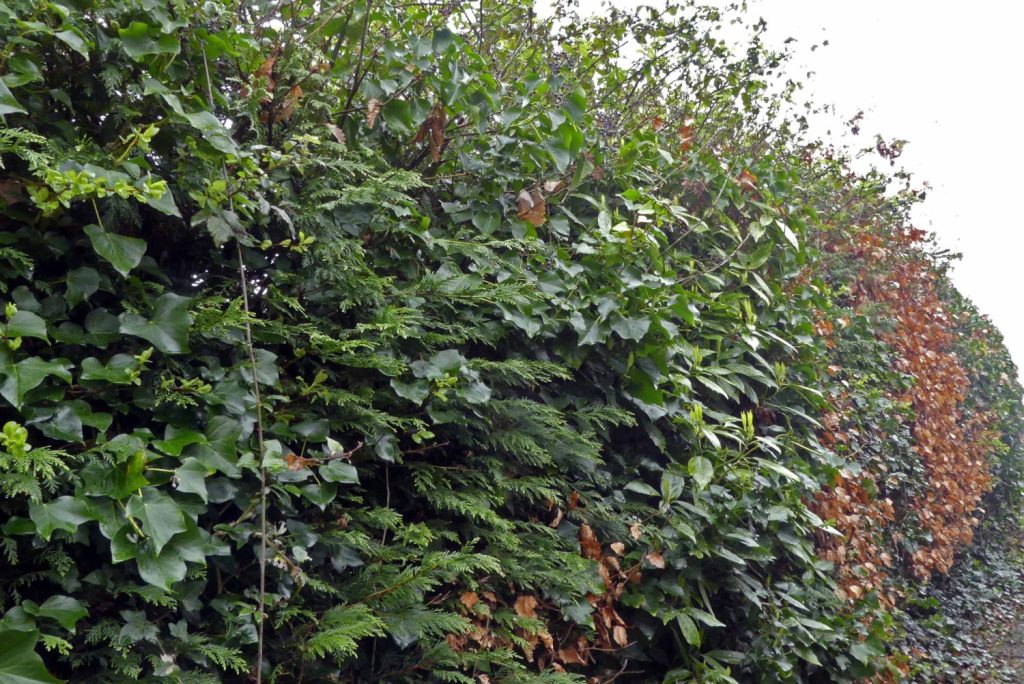
The row of cottages along the lane are a draw for a variety of bigger birds and most of the roofs, chimney pots and aerials have been claimed as perches, roosts or nest sites. Todays there were pairs of herring gull, wood pigeon, collared dove & jackdaw, all looking a bit ruffled and fed up with the weather.

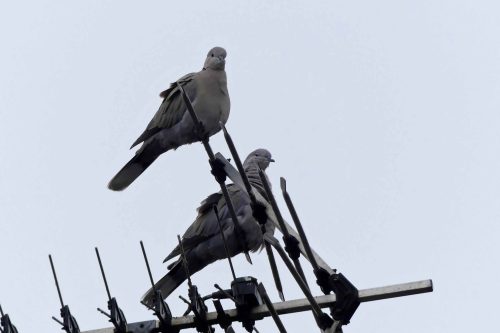

Fairy Glen
The river is visible once more, and down below at the bottom of the dell its sound is amplified by the steep banks that bound it. Birdsong adds to the music of the water, I pick out blackbirds, robins and great tit, then chiffchaff and blue tit. More raucously there’s the cooing of wood pigeons and the cawing of crows which remind of the closeness of houses.
The trees are still mostly leafless, but the steep sides of the dell and lack of bright sunlight keep it shady. At ground level there’s plenty of greenery from abundant ivy, lush ferns and patches of celandines. In places the well-trodden path is wet and muddy.
Great swathes of wild garlic cover much of the woodland floor and their pungent aroma fills the cool, damp air. It’s not flowering fully yet, but there are plenty of budding stems, so it won’t be long.
Someone’s been busy digging out a new pond
Here and there are little patches of early dog violets
and bright fresh green leaves of hazel
Although there are plenty of birds to be heard, I only had glimpses of foraging blue tits and robins that fly up from where they were singing as I got too close. I heard a nuthatch calling but couldn’t see him. Chiffchaffs continued to elude me. The only photograph I managed was of a wood pigeon keeping a beady eye on me from where it was tucked into a tall holly tree
Perhaps the birds sensed it was about to begin raining before I felt it. Time to turn around and head back.
Retracing my steps, still enjoying the sound of the river and birds singing despite the rain, I realised that I hadn’t met a single other person whilst I’d been here and had had all of this to myself.
Back out onto the lane, I met a man that lives in one of the cottages as he was putting out seed for the birds. He told me he does that twice a day and has his ‘morning birds’ and his ‘afternoon birds’. That probably accounts for the line of feral pigeons on his roof.
Re-joining the river in Llawr Pentre, I took this picture to show where it passes under the road and buildings, cropping out the cars that are always parked in a line close to the river’s edge.
Above the entrance to the underpass, watch out for the herring gull! This is one of several 2-dimensional images of our iconic irrepressible gulls that can be found located around Colwyn Bay.
Heading back through the gardens gives another chance to enjoy the glorious cherry blossom
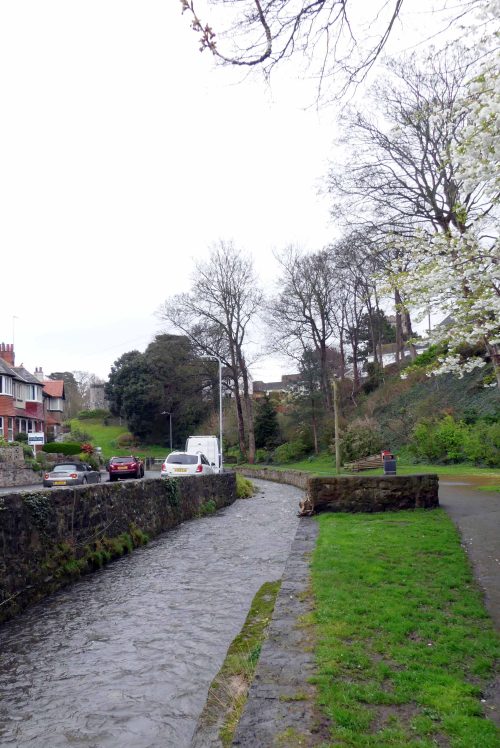

The indignant blackbird in a the tree below had just chased off another male.
Curving back through the gardens this is perhaps the best view of the river.
The final view of it is as it disappears into the culvert taking it beneath the road, the Expressway bridge and the viaduct where it has quite a sad end, emptying into Colwyn Bay as what is called an outfall.

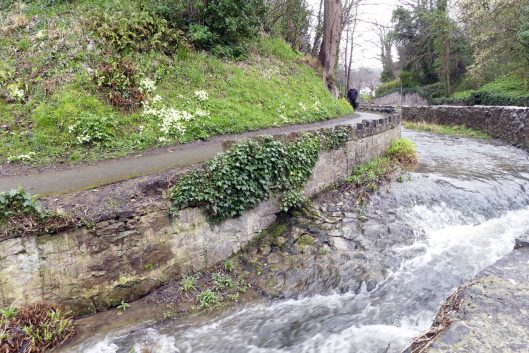
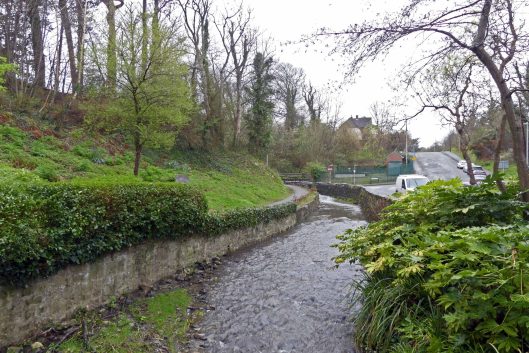


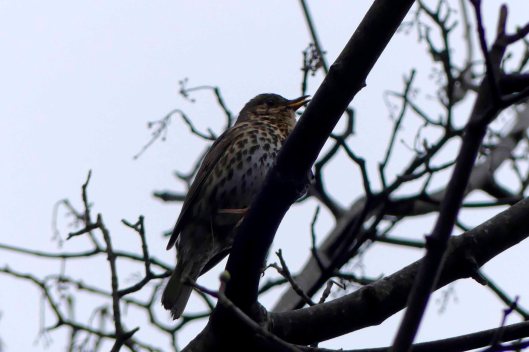
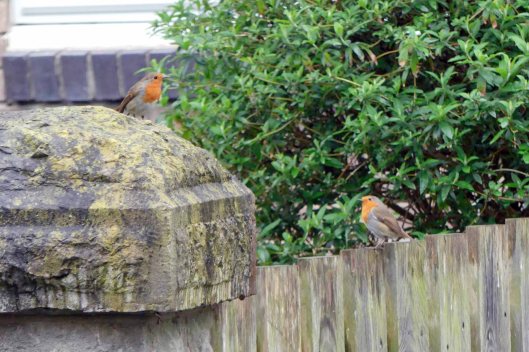



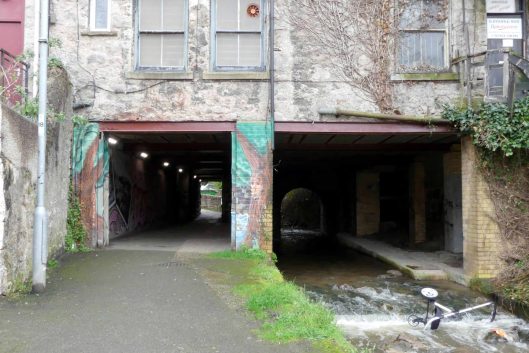




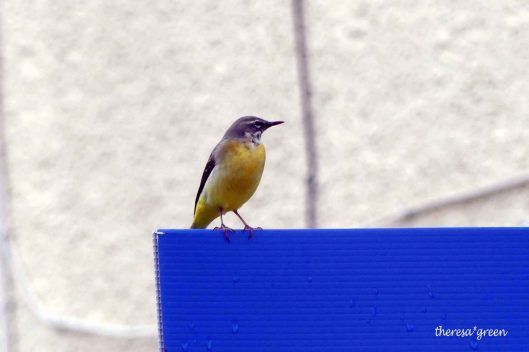

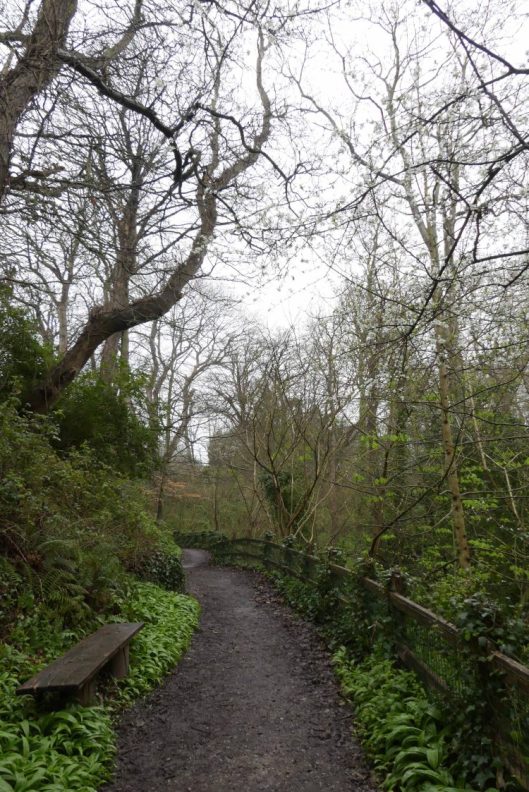
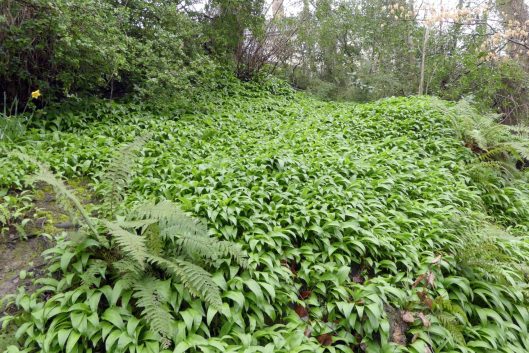
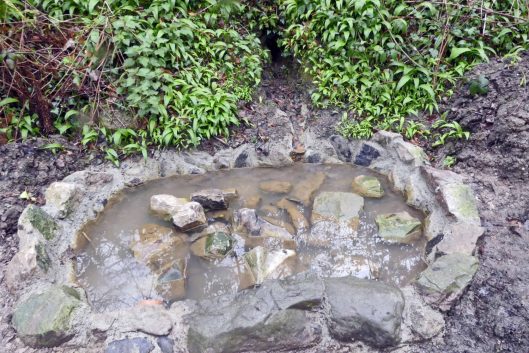
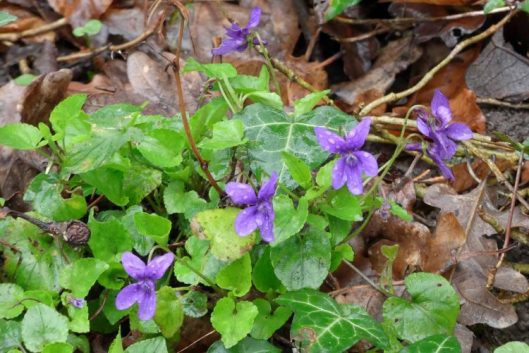


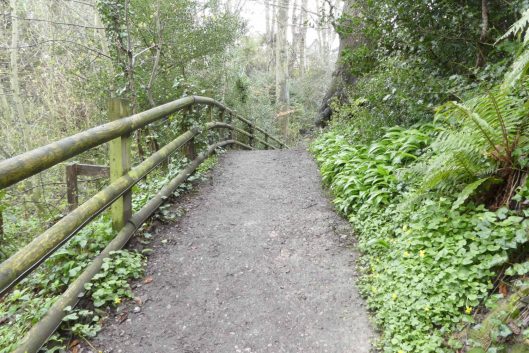

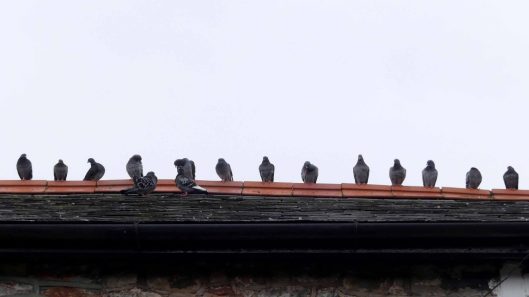

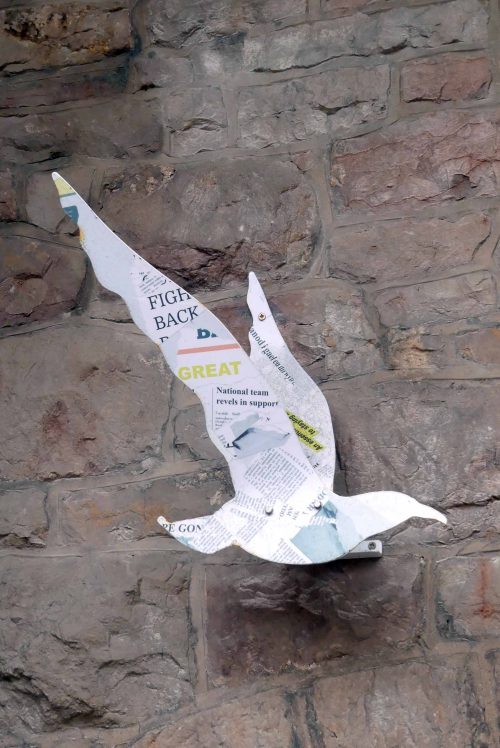

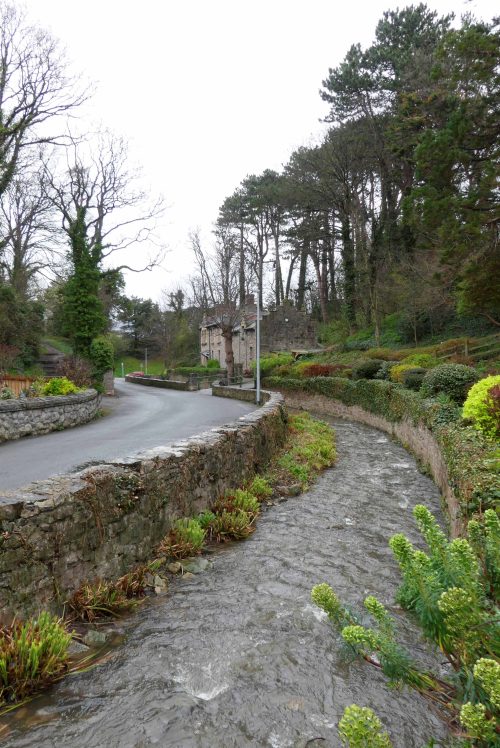
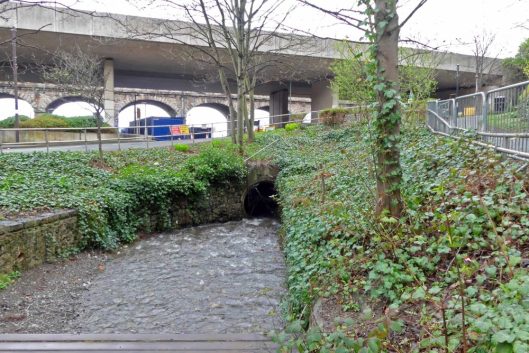
I have missed your posts so lovely to catch up on this walk where spring is coming to Colwyn bay.
LikeLike
You certainly came up with a good list of birds seen and heard Theresa. I love grey wagtails, they are so neat.
LikeLike
Hi Denzil, yes, a very healthy list with most species I’d hope to find here seen or heard. It’s such a relief to go to a place each year and find things pretty much as they were the year before! The wagtails are indeed smart little birds and it was fascinating to see some different behaviour.
LikeLike